TEHRAN, Oct. 14 -- This timeline delineates key moments in a decade-long standoff over Iran's nuclear program:
2002
August. The International Atomic Energy Agency (IAEA) learned via Iranian Paris-based exiled MEK organization that Iran had engaged in a host of undeclared nuclear activities in its two nuclear facilities of Natanz and Arak.
2003
June 6. Director General of the IAEA Mohamed ElBaradei declared, in a report, that Iran failed to report certain nuclear materials and activities under its NPT-required IAEA safeguards agreement. The IAEA urged Iran to fully cooperate with its inspectors.
Oct. 21. In the negotiations with Britain, France and Germany ( EU-3), Iran agreed to temporarily suspend uranium conversion and enrichment and to permit more inspections into its nuclear program.
2004
July 31. Iran said it had resumed building nuclear centrifuges to enrich uranium, reversing the October 2003 agreement with the EU-3 to suspend uranium enrichment-related activities. The United States contended that the purpose was to produce weapons-grade uranium.
Nov. 15. To avoid pressures by the West, Iran signed the so- called "Paris Agreement" with the EU-3. Under the pact, Iran committed to suspend its uranium conversion and enrichment activities temporarily and engage in negotiations with the EU-3 for a diplomatic solution to its nuclear issue.
2005
Aug. 8. The EU-3 offered a proposal to Iran which required Iran to cease enrichment for a long term in exchange for supplying the materials and fuel needed for Iran's research reactor. The proposal was rejected by Iran.
Aug. 8. Iran resumed the conversion of uranium at the Isfahan facility but said it did not engage in enrichment of uranium.
2006
April 11. Iran's President Mahmoud Ahmadinejad announced that Iran had enriched uranium to 3.5 percent purity.
July 31. The UNSC passed a resolution that demanded Iran to suspend enrichment and other nuclear fuel-making activities.
Dec. 23. Resolution 1737 was passed by the UNSC against Iran for failing to stop its uranium enrichment program. It banned the supply of nuclear-related technology and materials and froze the assets of key individuals and companies related to the enrichment program.
2007
March 24. Resolution 1747 was adopted by the UNSC. In the resolution, the Council resolved to tighten the sanctions already imposed on Iran. It also resolved to impose a ban on arms sales and to step up the freeze on assets already in place.
April 9. Ahmadinejad announced that Iran could produce nuclear fuel on an industrial scale.
2008
March 3. The UNSC adopted Resolution 1803, which extended financial sanctions to additional banks, extended travel bans to additional persons and barred exports to Iran of nuclear and missile-related dual-use items.
2009
April 9. Iran said it had installed 7,000 uranium enrichment centrifuges at Natanz.
Sept. 25, 2009. Iran admitted to the IAEA that it was constructing Fordow uranium enrichment underground bunker near the holy city of Qom in central Iran. The reports said that the facilities were already disclosed by Western intelligence agencies.
2010
May 17. Iran, Turkey and Brazil announced a deal on procedures for a nuclear "fuel swap" aimed at easing concerns over Tehran's nuclear program, but it met with little success.
June 9. The UNSC passed a new resolution that imposed further sanctions on Iran's nuclear-related activities, Iran's shipping activities and the Iran's Islamic Revolutionary Guard Corps (IRGC).
July 1. U.S. President Barack Obama signed into law the Comprehensive Iran Sanctions which targeted foreign individuals and entities that aid Iran's oil sector.
Nov. 29. A top Iranian nuclear scientist was killed in a bomb blast. Another blast injured the other nuclear scientist. Iran blamed Israel and the West for the incidents.
2011
Jan. 22. Iran and the P5+1 held talks in Istanbul, Turkey, but failed to reach any agreement.
Nov. 8. An IAEA report said that there were "serious concerns" about Iran's nuclear activities pursuant to the "credible" information that Iran might be working on developing nuclear- related weapons.
Dec. 31. Obama administration imposed sanctions on financial transactions with the Central Bank of Iran.
2012
Jan. 1. Iran announced testing nuclear fuel rods for the use in its research reactor.
Jan. 11. Another Iranian nuclear scientist was assassinated in a car bomb attack.
April 14. Six world powers held crucial talks with Iran on its nuclear program in Istanbul of Turkey. The talks were continued on May 24 in Baghdad and on June 18 in Moscow. However, Iran and the powers remained splitted over the key issues.
July 1. The EU sanctions, approved by the EU foreign against Tehran in January 2012, came into effect. The sanctions prevented EU member states from buying the Iranian crude.
July 31. President Obama announced additional sanctions against Iran's energy and petrochemical sectors.
Aug. 30. An IAEA report said Iran had expanded its potential capacity to refine uranium in Fordow by doubling its centrifuges from 1,064 to 2,140. Another IAEA report said on Nov. 16 that Iran expanded the number of its installed centrifuges at Fordow to nearly 2,800.
2013
Feb. 13. Experts of the IAEA met in Tehran but could not finalize the "structured approach" document which could allow the IAEA inspectors to gain access to some of Iran's nuclear and military sites. The IAEA and Iran had met twice in December 2012 and in January 2013 to finalize the deal over the nuclear program, but they failed to reach any agreement.
Feb. 27. Iran and the P5+1 concluded a meeting on the country's nuclear issue in Almaty of Kazakhstan and agreed to hold another meeting in April. The Almaty-2 nuclear talks ended in Kazakhstan on April 6 without tangible results.
May 22. An IAEA report said Iran continued to install the IR-2m centrifuges in Natanz, which could promote its uranium enrichment significantly.
June 3. Obama administration sanctioned transactions in Iran's currency and banned sales of goods or services for the manufacturing or assembling in Iran of light and heavy vehicles.
June 5. The IAEA issued a new statement, expressing "deep concern" that Iran continued to install advanced centrifuges, production of enriched uranium and construction of the IR-40 reactor at Arak.
June 17. Iran's new President Hassan Rouhani said his country will try to be more "transparent" in its nuclear issue to "build confidence." He also urged the United States to "recognize Iran's nuclear rights."
July 1. New U.S.sanctions banned gold sales to and trades in gold with the Islamic republic.
Sept. 26. Iran and the P5+1 foreign ministers met on the sidelines of the UN General Assembly and agreed on a new round of talks over Iran's nuclear issue in Geneva on Oct. 15-16.
Sept. 27. President Rouhani held a groundbreaking direct telephone conversation with President Obama upon leaving New York. In the first talk between the two countries' presidents after more than 30 years, they exchanged views on Iran's nuclear issue.
Oct. 13. Iran's chief negotiator for upcoming nuclear talks Abbas Araqchi said Iran would neither ship out its enriched uranium nor stop uranium enrichment activities. However, Iran is ready for more transparency over the country's nuclear program, he added.
 2013 Colour Me Rad 5K run held in Canada
2013 Colour Me Rad 5K run held in Canada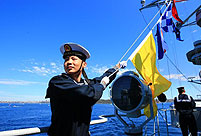 China's destroyer Qingdao sails out of Sydney Harbor
China's destroyer Qingdao sails out of Sydney Harbor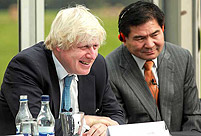 Chinese tycoon aims to restore London's Crystal Palace
Chinese tycoon aims to restore London's Crystal Palace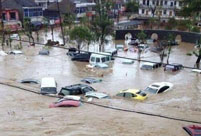 Worst flooding hits Yuyao, 70% of downtown area underwater
Worst flooding hits Yuyao, 70% of downtown area underwater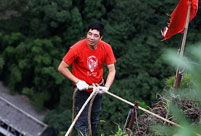 Game for the brave: 'Spiders' in Yandang Mountains
Game for the brave: 'Spiders' in Yandang Mountains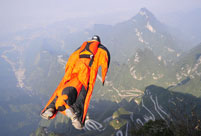 Hungarian wingsuit flyer confirmed dead in Zhangjiajie
Hungarian wingsuit flyer confirmed dead in Zhangjiajie New couples take wedding photos during holiday
New couples take wedding photos during holiday Serena Williams stumbles through to quarterfinals
Serena Williams stumbles through to quarterfinals Thailand Mobile Expo 2013 kicks off
Thailand Mobile Expo 2013 kicks off Photo collection of Chinese Navy
Photo collection of Chinese Navy Photo story: Young tenants in Beijing
Photo story: Young tenants in Beijing Twins Culture Festival kicks off in Beijing
Twins Culture Festival kicks off in Beijing UNESCO world heritage site: Montale Tower
UNESCO world heritage site: Montale Tower Israeli drone crashes into Mediterranean, fragments recovered
Israeli drone crashes into Mediterranean, fragments recovered Serena Williams wins second China Open title
Serena Williams wins second China Open titleDay|Week|Month